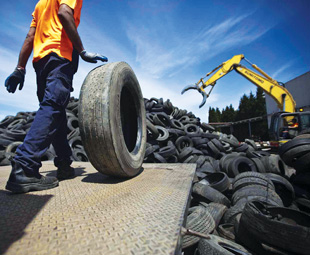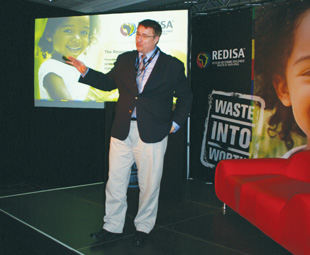Recycling the wheel

Tyres, like electricity, are things we can’t do without. However, they have a huge impact on our environment. THINUS VAN ROOYEN takes a look at tyre recycling and the challenges faced by this concept in South Africa.
Tyre waste is a huge global problem with serious environmental repercussions. In South Africa the traditional method of dealing with old and used tyres is to dump them at the closest landfill. When the pile of unwanted used tyres becomes too high, they are often burnt – creating large amounts of air pollution. As with other forms of garbage, tyres are also often dumped at illegal sites.
This is where the Recycling and Economic Development Initiative of South Africa (Redisa) steps in. Redisa aims to create a sustainable system in which used tyres are recycled throughout the country for various purposes. To promote its system of tyre recycling, Redisa held a Roadshow event at the Sandton Holiday Inn on October 10, to discuss its plan forward and address the challenges it currently faces.
Redisa’s CEO Hermann Erdmann presented its plan for the future to the tyre industry. “South Africa only recycles about 10 percent of its waste,” he says. “Our plan is to turn tyre waste into a commodity.”
 According to Redisa, there are about 60 million used tyres in South Africa. However, that number is expected to increase to a titanic 170 million within the next decade.
According to Redisa, there are about 60 million used tyres in South Africa. However, that number is expected to increase to a titanic 170 million within the next decade.
Redisa’s plan to fight this growing problem is to subsidise the collection and recycling process by attaching a value to the collection of waste tyres. In short, by making recycling profitable Redisa hopes to ensure that people will actively recycle tyres.
“We have to create a sustainable recycling industry,” says Erdmann. “Redisa will create approximately 10 000 jobs and will also promote research and development in polymer technologies.”
With this incentive in place, individuals and small entrepreneurs will proactively seek out tyres that have been dumped, discarded or thrown away. This means that the environment will benefit and so will our economy.
During the recycling process tyre rubber is ground into crumbs which can be used for road construction. Secondary industries also use this ground rubber to create carpets, boots, umbrellas, and even solid rubber tyres that do not have steel plating and wiring inside them. The steel innards are melted down for other purposes.
Redisa’s plan for the future has not been without some hiccups, however. Various attendees voiced their displeasure at, among other things, the fact that there are not yet enough depots throughout the country. This has resulted in large piles of used tyres that have not yet been collected.
“Unfortunately, what we’re striving towards will not happen overnight,” says Erdmann. “We are already building new plants for recycling, and these will be opened within the next 18 months.”
Currently, Redisa has depot sites that are running successfully in KwaZulu-Natal, the Western Cape and Gauteng. Should everything run smoothly, Redisa’s network of tyre recycling depots will take five years to be fully up and running.
“We aim to change tyre recycling into a business problem and not an environmental one,” says Erdmann. “Companies must deal with the impact of tyre recycling or fall behind the pack.”
If left unchecked, tyres will continue to be an environmental threat for many communities. Redisa has voiced its intentions with its extensive marketing campaign and is the only non-profit programme for tyre recycling in South Africa.
A lot rests on Redisa’s shoulders, but it would seem that South Africa can expect a greener future where tyre recycling is concerned.
Published by
Focus on Transport
focusmagsa




